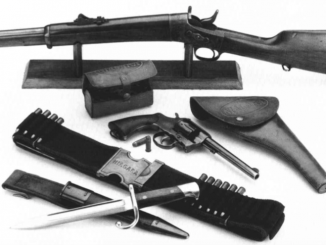The Lamson & Ball repeating carbine was one of the last Civil War arms manufactured, as an initial order of 1,000 units was placed in June of 1864 but not actually delivered until April and May of 1866. The delay was in large part caused by the government changing the caliber after the order had been placed, from .44 to the newly standardized .56-50 Spencer cartridge. The manufacturer was E.G. Lamson, who was an industrialist who had puchased the defunct Robbins & Lawrence rifle factory in 1858. He had done this with the intention of making sewing machines and other mechanical products, and jumped at the opportunity to take arms contracts once the Civil War erupted.
The Ball carbine is in some ways a mixture of Spencer and Henry elements, with an independent hammer and lever like a Spencer, but an under-barrel tube magazine (capacity of 7 rounds) like a Henry. The most interesting feature of the Ball was how it split the chamber into two separate pieces, and used the lower one as a cartridge elevator. This system apparently worked quite well when new, but suffered accuracy problems as the components started to wear with use.




What a handsome design. It appears to be one of the simplist & strongest designs for that period. Everything was changing so rapidly I don’t think we have ever experienced so many changes in firearms in such a short period of time. Thanks for showing this carbine to us!
“firearms in such a short period of time”
Indeed introduction of breech-loading weapons and metallic cartridge give so big combat advantage (see Königgrätz 1866, where Prussia used breech-loading one-piece-cartridge [not metallic yet] weapons against muzzle-loaders armed Austrians) that any serious military forces were seeking from breech-loaders, often conversion, so weapons in inventory might be used, which would result in lower price.
I would say that (roughly) 100 years between Napoleonic Wars and outbreak of First World War give bigger progression in fire-arms that 100 years since 1914.
“split the chamber”
This isn’t encountered often in fire-arms, however there was Fokker-Leimberger aircraft machine gun of WW1 era, see drawings here:
http://www.dogswar.ru/oryjeinaia-ekzotika/strelkovoe-oryjie/6274-pylemet-fokker-leimb.html
where such construction mean that there was not forward-backward movement unlike most machine guns.
And there was also Mk18Mod0 crank grenade launcher:
https://en.wikipedia.org/wiki/Mk_18_Mod_0_grenade_launcher
notice that it uses low-pressure ammunition.
I’d suspect the major problem with such a “split chamber” in later years would be that higher-pressure ammunition would probably result in case separations.
Interestingly, in Petersen’s Guns of the World (1972), the article on Civil War Union cavalry carbines by Andrew F. Lustyik (pp.96-109) credits the Ball with a magazine capacity of “nine 56-.50 Spencer rounds or twelve of the shorter .50 Ball Repeater cartridges”. I have found no other reference to this “shorter” cartridge.
I suspect that the author of the article, or his references, may have been confusing two different Spencer rounds, the .56-50 and the .56-52. Both were actually .50 caliber, but the .56-52 was (counter-intuitively) the shorter of the two, with a case length of 1.035in and an OAL of 1.5in exactly, vs. 1.156in and 1.632in, respectively, for the .56-50 round.
Perhaps at some point some dummy Spencer rounds could be concocted to find out exactly how many really will “drop in” to the Ball’s tubular magazine.
cheers
eon
This design, if it had stuck around for any reason past the Reconstruction Era, would necessitate the presence of constant oiling or extremely tough cartridge cases. And one would want a gas vent added to reduce the likeliness of “chamber goes boom and kills the user.” I could be wrong.
“This design, if it had stuck around for any reason past the Reconstruction Era, would necessitate the presence of constant oiling or extremely tough cartridge cases”
Or usage of limited-pressure cartridges.
“case separations”
This was case in Fokker-Leimberger, https://en.wikipedia.org/wiki/Fokker-Leimberger
Referring to the other examples on offer, the two patents stamped into the side of the receiver are these:
US38935 – the original Ball patent of June 23, 1863
USRE1635 – the reissue of the above patent on March 15, 1864 (with more detailed description of claims)
Also:
US45307 – patent of December 6, 1864 for the magazine.
US43827 – patent of August 16, 1864 for another lever repeater design.
Plug those numbers into your favorite patent search engine to read the text.
Enjoy!
.12 cents in 1901 is about $3.25 in todays dollars. So I’ll take two of them for 10 bucks and you can keep the change!!!
Great work as always Ian!!
“.12 cents in 1901 is about $3.25 in todays dollars”
What about price of ammunition?